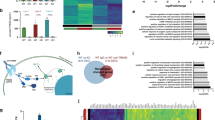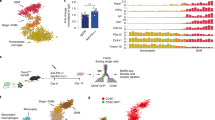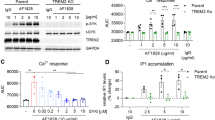Abstract
Variants in the triggering receptor expressed on myeloid cells 2 (TREM2) have been associated with increased risk for sporadic, late-onset Alzheimer’s disease. Here we show that germline knockout of Trem2 or the TREM2R47H variant reduces microgliosis around amyloid-β plaques and facilitates the seeding and spreading of neuritic plaque tau aggregates. These findings demonstrate a key role for TREM2 and microglia in limiting the development of peri-plaque tau pathologies.
This is a preview of subscription content, access via your institution
Access options
Access Nature and 54 other Nature Portfolio journals
Get Nature+, our best-value online-access subscription
$29.99 / 30 days
cancel any time
Subscribe to this journal
Receive 12 print issues and online access
$209.00 per year
only $17.42 per issue
Buy this article
- Purchase on Springer Link
- Instant access to full article PDF
Prices may be subject to local taxes which are calculated during checkout



Similar content being viewed by others
Data availability
The data that support the findings of this study are available from the corresponding author upon request.
References
Gratuze, M., Leyns, C. E. G. & Holtzman, D. M. Mol. Neurodegener. 13, 66 (2018).
Del-Aguila, J. L. et al. J. Alzheimers Dis. 62, 745–756 (2018).
Götz, J., Ittner, L. M., Schonrock, N. & Cappai, R. Neuropsychiatr. Dis. Treat. 4, 1033–1042 (2008).
Ulrich, J. D. et al. Mol. Neurodegener. 9, 20 (2014).
Wang, Y. et al. Cell 160, 1061–1071 (2015).
Jay, T. R. et al. J. Exp. Med. 212, 287–295 (2015).
Yuan, P. et al. Neuron 92, 252–264 (2016).
Song, W. M. et al. J. Exp. Med. 215, 745 (2018).
Jay, T. R. et al. J. Neurosci. 37, 637–647 (2017).
Wang, Y. et al. J. Exp. Med. 213, 667–675 (2016).
Cheng-Hathaway, P. J. et al. Mol. Neurodegener. 13, 29 (2018).
Parhizkar, S. et al. Nat. Neurosci. 22, 191–204 (2019).
Nelson, P. T. et al. J. Neuropathol. Exp. Neurol. 71, 362–381 (2012).
He, Z. et al. Nat. Med. 24, 29–38 (2018).
Condello, C., Yuan, P., Schain, A. & Grutzendler, J. Nat. Commun. 6, 6176 (2015).
Guo, J. L. et al. J. Exp. Med. 213, 2635–2654 (2016).
Sadleir, K. R. et al. Acta Neuropathol. 132, 235–256 (2016).
Leyns, C. E. G. et al. Proc. Natl Acad. Sci. USA 114, 11524–11529 (2017).
Bemiller, S. M. et al. Mol. Neurodegener. 12, 74 (2017).
Sayed, F. A. et al. Proc. Natl Acad. Sci. USA 115, 10172–10177 (2018).
Radde, R. et al. EMBO Rep. 7, 940–946 (2006).
Turnbull, I. R. et al. J. Immunol. Baltim. 177, 3520–3524 (2006).
Yanamandra, K. et al. Neuron 80, 402–414 (2013).
Acknowledgements
This study was supported by the National Institute of Aging AG053976 (C.E.G.L.), AG059082 (M.C.), AG059176 (M.C.), AG026276 (D.M.H.), AG03991 (D.M.H.), AG05681 (D.M.H.), JPB Foundation (D.M.H.), the Donor’s Cure Foundation (J.D.U.), and the Cure Alzheimer’s Fund (D.M.H., M.C.). Scanning of immunohistochemistry was performed on the NanoZoomer digital pathology system courtesy of the Hope Center Alafi Neuroimaging Laboratory. Confocal data were generated on a Zeiss LSM 880 Airyscan Confocal Microscope, which was purchased with support from the Office of Research Infrastructure Programs (ORIP), a part of the NIH Office of the Director under grant OD021629, and in part with support from the Washington University Center for Cellular Imaging (WUCCI). The authors specifically thank M. Shih for his help in automating MATLAB scripts for data quantification, K. Campbell for her assistance with figure design in R studio, and L. Changolkar for assistance with the AD-tau preparation.
Author information
Authors and Affiliations
Contributions
C.E.G.L., J.D.U., and D.M.H. conceived the study. C.E.G.L., M.C., V.M.Y.L., J.D.U., and D.M.H. designed the study. C.E.G.L., M.G., S.N., N.J., L.J.K., H.J., M.M., and J.D.U. performed the experiments and analyzed the data. C.E.G.L., J.D.U., and D.M.H. wrote the manuscript. All authors discussed the results and commented on the manuscript.
Corresponding authors
Ethics declarations
Competing interests
D.M.H., J.D.U., and H.J. are listed as inventors on a provisional patent from Washington University on TREM2 antibodies. D.M.H., H.J., and C.E.G.L. are listed as inventors on a patent licensed by Washington University to C2N Diagnostics on the therapeutic use of anti-tau antibodies. C.E.G.L. is currently an employee at Merck. M.C. receives research funding from Alector, Amgen, and Ono. D.M.H. co-founded and is on the scientific advisory board of C2N Diagnostics. C2N Diagnostics has licensed certain anti-tau antibodies to AbbVie for therapeutic development. D.M.H. is on the scientific advisory board of Proclara and Denali and consults for Genentech, Eli Lilly, and AbbVie. All other authors have no competing interests.
Additional information
Journal peer review information: Nature Neuroscience thanks Terrence Town, Marie-Ève Tremblay, and the other, anonymous, reviewer(s) for their contribution to the peer review of this work.
Publisher’s note: Springer Nature remains neutral with regard to jurisdictional claims in published maps and institutional affiliations.
Integrated supplementary information
Supplementary Figure 1 AD-tau seeding increases NP tau in APPPS1-21 mice without altering fibrillar plaque load.
a, Representative images of X34 fibrillar plaques in unseeded and AD-tau seeded APPPS1-21 mice. Scale bars 100 microns. b, c, d, e, Quantification of the percent area covered by X34 staining in the ipsi and contra cortices (t(8), ipsilateral P=0.4636, contralateral P=0.6152) and hippocampi (t(8), ipsilateral P=0.8356, contralateral P=0.4870) of unseeded and seeded mice. f, Representative images of AT8-labeled NP tau burden in unseeded and AD-tau seeded APPPS1-21 mice. Scale bars 1mm. g, h, i, j, Quantification of the percent area covered by AT8 staining in the ipsi and contra cortices (t(8), ipsilateral **P=0.0027, contralateral P=0.0719) and hippocampi (t(8), ipsilateral **P=0.0065, contralateral P=0.0659) of unseeded and seeded mice. k, Confocal images of cortical AT8+ NP tau (red) around X34+ plaques (blue). Scale bars 50µm. l, m, Quantification of the percent of AT8+ voxels within 15µm of plaques in unseeded and seeded APPPS1-21 mice (t(8), ipsilateral *P=0.0404, contralateral ***P=0.0006). Significance determined by unpaired, two-sided student’s t-test for unseeded (n = 4 mice) and seeded (n = 6 mice) mice. Note that seeded mice are the same T2WT mice reported in Fig. 1. Individual data points are plotted for each group with mean ± standard error of the mean (SEM).
Supplementary Figure 2 No human tau is detected at 3 months p.i. in AD-tau seeded APPPS1-21 mice.
Images of immunostaining for human tau in a transgenic PS19 mouse that overexpresses human tau (top panel), a naïve 8.5mo APPPS1-21 mouse (T2WT) (middle panel), and an AD-tau treated 8.5mo APPPS1-21 mouse (T2WT) at 3 months p.i. (bottom panel). Scale bars 500µm, 50µm for high-powered inset images. This staining experiment was performed on this tissue set once.
Supplementary Figure 3 No seeded NP tau aggregates are present in T2WT and T2KO mice at 3 months p.i.
Representative images of AT8 p-tau immunostaining in 8.5mo old T2WT and T2KO mice, 3 months p.i. AD-tau. Scale bars 500µm. This staining experiment was performed on this tissue set once.
Supplementary Figure 4 Comparison of fibrillar amyloid-β plaque burden across TREM2 genotypes in APPPS1-21 mice 3 months p.i. AD-tau.
a, Representative images of X34 fibrillar plaques in AD-tau seeded APPPS1-21 T2WT and T2KO mice. Scale bars 100 μm. b, c, d, e, Quantification of the percent area covered by X34 staining in the cortex (t(11), ipsi P=0.0585, contra P=0.2578) and hippocampus (t(11), ipsi **P=0.0063, contra *P=0.0223) of seeded APPPS1-21 T2WT and T2KO mice. f, Representative images of X34 fibrillar plaques in AD-tau seeded APPPS1-21 T2CV and T2R47H mice. Scale bars 100 μm. g, h, i, j, Quantification of the percent area covered by X34 staining in the cortex (t(12), ipsilateral P=0.4285, contralateral P=0.5886) and hippocampus (t(12), ipsilateral P=0.1481, contralateral P=0.1372) of seeded APPPS1-21 T2CV and T2R47H mice. Significance determined by unpaired, two-sided student’s t-test for T2WT (n = 6 mice) and T2KO (n = 7 mice) or T2CV (n = 7 mice) and T2R47H (n = 7 mice). Individual data points are plotted for each group with mean ± standard error of the mean (SEM).
Supplementary Figure 5 Analysis of NFTs in AD-tau seeded mice 3 months p.i.
a, b, Representative images of NFT quantification from AT8 staining in the ipsi cortex and hippocampus of AD-tau seeded mice at 3 months p.i. Scale bars 50µm. c, d, e, f, Quantification of NFTs from the ipsi and contra hemispheres (cortex and hippocampus) of seeded APPPS1-12 T2WT and T2KO (t(11), ipsilateral P=0.6801, contralateral P=0.6511) (c,d) and T2CV and T2R47H mice (t(12), ipsilateral P=0.3491, contralateral P>0.9999) (e,f). Significance determined by unpaired, two-sided student’s t-test for T2WT (n = 6 mice) and T2KO (n = 7 mice) or T2CV (n = 7 mice) and T2R47H (n = 7 mice). Individual data points are plotted for each group with mean ± standard error of the mean (SEM).
Supplementary Figure 6 NP tau and amyloid-β42 are increased around X34+ plaques regardless of plaque size.
a, b, AT8+ NP tau data from Fig. 1i and k was re-analyzed as a function of average plaque size per image by dividing the total X34+ voxels per image by the number of X34 surfaces. Significant genotype effects were observed for seeded APPPS1-21 T2WT and T2KO (F(1, 111) P<0.0001; <75000: P<0.0001, 75000-125000: P=0.0005, >125000: P<0.0001) (a) and T2CV and T2R47H (F(1, 84) P<0.0001; <75000: P=0.4399, 75000-125000: P=0.0272, >125000: P<0.0001) (b) mice regardless of plaque size. c,d, amyloid-β42 data from Fig. 2k and m was re-analyzed as a function of average plaque size as previously described; significant genotype effects were seen for APPPS1-21 T2WT and T2KO (F(2, 111) P<0.0001; <75000 P<0.0001, 75000-125000 P=0.0004, >125000 P=0.0147) (c) and T2CV and T2R47H (F(1, 84) P<0.0001; <75000 P=0.7983, 75000-125000 P=0.1178, >125000 P<0.0001) (d) mice regardless of plaque size. The number of images within each plaque size range varied; <75000 (T2WT n = 27 images, T2KO n = 22 images) (T2CV n = 9 images, T2R47H n = 13 images), 75000-125000 (T2WT n = 17 images, T2KO n = 23 images) (T2CV n = 12 images, T2R47H n = 13 images), >125000 (T2WT n = 11 images, T2KO n = 17 images) (T2CV n = 21 images, T2R47H n = 22 images). Significance reported for genotypes within each plaque size range as determined by a two-way ANOVA with Tukey post hoc test. Data are plotted as individual points with mean ± SEM.
Supplementary Figure 7 Fibrillar NP tau is increased in TREM2 deficient mice.
a, b, Representative images of AT8 (red) co-localized with X34 (green), indicative of fibrillar p-tau aggregates, in the ipsilateral cortex of AD- tau seeded T2WT and T2KO (a) and T2CV and T2R47H mice (b). Scale bars 50µm. c, d, Quantification of the percent of co-localized AT8 and X34 voxels per plaque from the ipsi cortex of seeded T2WT and T2KO (t(11), ***P=0.0002) (c) and T2CV and T2R47H mice (t(12), **P=0.0082) (d). Significance determined by unpaired, two-sided student’s t-test for T2WT (n = 6 mice) and T2KO (n = 7 mice) or T2CV (n = 7 mice) and T2R47H (n = 7 mice). Individual data points are plotted for each group with mean ± standard error of the mean (SEM).
Supplementary Figure 8 TREM2R47H/R62H but not APOEε4 genotype influences NP tau deposition around amyloid-β plaques.
a, The percent of AT8+ NP tau within 15µm of X34+ plaques is significantly affected by TREM2R47H/R62H genotype (F(1, 21) ***P=0.0002), but not APOEε4 genotype (F(1, 21) P=0.2941). b, The percent of amyloid-β42 within 15µm of X34+ plaques was not affected by TREM2R47H/R62H (F(1, 21) P=0.4266) or APOEε4 genotype (F(1, 21) P=0.5555). Significance determined by two-way ANOVA with Tukey post hoc test for APOEε4 +/TREM2CV (n = 7 cases), APOEε4 +/TREM2R47H/R62H (n = 8 cases), APOEε4 -/TREM2CV (n = 5 cases), and APOEε4 -/ TREM2R47H/R62H (n = 5 cases). Individual data points are plotted for each group with mean ± standard error of the mean (SEM).
Supplementary information
Supplementary Information
Supplementary Figures 1–8 and Supplementary Tables 1 & 2.
Rights and permissions
About this article
Cite this article
Leyns, C.E.G., Gratuze, M., Narasimhan, S. et al. TREM2 function impedes tau seeding in neuritic plaques. Nat Neurosci 22, 1217–1222 (2019). https://doi.org/10.1038/s41593-019-0433-0
Received:
Accepted:
Published:
Issue Date:
DOI: https://doi.org/10.1038/s41593-019-0433-0
This article is cited by
-
Immunological aspects of central neurodegeneration
Cell Discovery (2024)
-
Xenografted human microglia display diverse transcriptomic states in response to Alzheimer’s disease-related amyloid-β pathology
Nature Neuroscience (2024)
-
Loss of TMEM106B exacerbates Tau pathology and neurodegeneration in PS19 mice
Acta Neuropathologica (2024)
-
TREM1 disrupts myeloid bioenergetics and cognitive function in aging and Alzheimer disease mouse models
Nature Neuroscience (2024)
-
Microglial function, INPP5D/SHIP1 signaling, and NLRP3 inflammasome activation: implications for Alzheimer’s disease
Molecular Neurodegeneration (2023)



